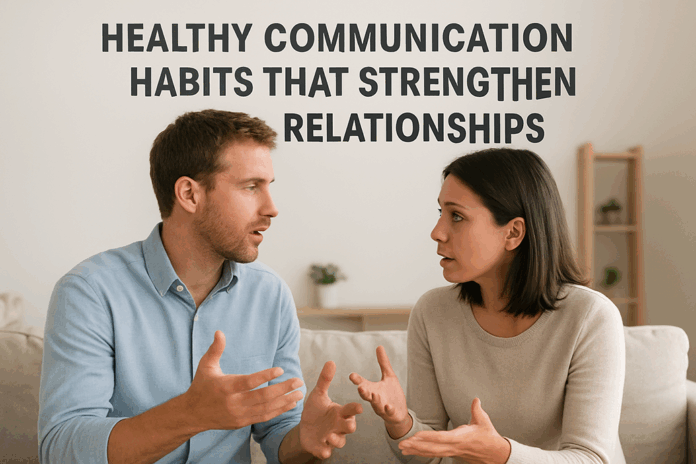Every relationship — whether romantic, platonic, or professional — thrives or falls apart based on one simple thing: communication. It’s not how much we talk that matters, but how well we connect. Have you ever tried explaining something to someone, only to feel like they’re hearing every word but understanding none of it? That invisible wall of misunderstanding is what unhealthy communication feels like — frustrating, isolating, and disheartening.
Healthy communication, on the other hand, builds bridges. It’s the heartbeat of trust, empathy, and emotional safety. When we learn to express ourselves honestly and listen with intention, relationships transform from fragile connections into resilient partnerships. It’s not about saying the “right” thing; it’s about creating space for understanding.
In this article, we’ll explore research-backed communication habits that strengthen relationships — habits you can apply in love, friendship, family, and even at work. Whether you’re trying to reconnect with a partner or simply want to express yourself better, these principles will help you build deeper, more meaningful connections.
Understanding Healthy Communication
What Does “Healthy Communication” Really Mean?
At its core, healthy communication means expressing yourself clearly and listening actively, without judgment or defensiveness. It’s the balance between speaking your truth and being open to another’s perspective. According to renowned psychologist Dr. John Gottman, couples who communicate effectively have a 94% chance of resolving conflict peacefully — not because they never disagree, but because they know how to talk about it without tearing each other down.
Healthy communication is grounded in emotional intelligence — the ability to recognize, understand, and manage your emotions while empathizing with others. It’s about replacing reaction with reflection, and criticism with curiosity.
Think of it like learning a new language — the language of connection. You’re not just exchanging words; you’re tuning in to emotion, tone, and unspoken meaning. Every gesture, pause, and sigh holds information about how someone truly feels.
When communication is healthy, you feel seen, heard, and respected. There’s no scorekeeping, no silent resentment — just mutual effort to understand.
Why Communication Shapes Every Relationship
Every thriving relationship rests on one simple foundation: feeling understood. Communication shapes how we interpret love, resolve tension, and share dreams. When it’s healthy, it fuels closeness; when it’s broken, it breeds loneliness.
Research from The Journal of Family Psychology shows that couples who engage in open and respectful dialogue report higher relationship satisfaction and longer-lasting partnerships. Similarly, in friendships and workplaces, good communication fosters trust and cooperation, reducing conflict and boosting emotional well-being.
Imagine two people standing on opposite sides of a river. Their words are the bridge. If the bridge is unstable — full of blame, sarcasm, or avoidance — no one feels safe crossing. But when communication is clear, compassionate, and consistent, it becomes a solid path toward understanding.
Healthy communication doesn’t mean you never argue. It means you argue better — with empathy, patience, and purpose. It’s the secret ingredient in every strong relationship, and it starts with small, intentional habits practiced every day.
Common Barriers to Healthy Communication
The Silent Killer – Assumptions and Misinterpretations
Assumptions are like fog in communication — they blur reality and distort meaning. We assume someone “should know” how we feel or what we meant, and when they don’t, resentment builds. Most misunderstandings don’t come from bad intentions but from unspoken expectations.
For example, one partner might say, “You never listen to me,” when what they really mean is, “I feel unimportant when you’re distracted.” The difference between accusation and expression is monumental. One closes doors; the other opens them.
The best way to overcome assumptions is to seek clarity. Instead of interpreting, ask: “Can you tell me what you meant by that?” or “Here’s how I understood — is that what you meant?” These small questions prevent massive emotional drift.
Healthy communicators replace assumptions with curiosity. They don’t assume they’re right — they aim to understand.
Emotional Reactivity and Defensive Listening
We’ve all been there — someone says something that stings, and before we know it, we’re reacting, not responding. Emotional reactivity is when our nervous system hijacks rational thinking. We listen not to understand but to defend ourselves.
According to emotional regulation research from the American Psychological Association, our brains perceive emotional threats similarly to physical danger. When we feel attacked, we enter “fight or flight” mode — and real listening stops.
To counter this, pause before responding. Take a breath, name what you feel, and remind yourself: “My goal is to connect, not to win.” This shift transforms conversations from battlegrounds into safe spaces for growth.
When both people manage reactivity, even disagreements become productive. You can disagree and still feel respected — that’s the hallmark of mature, healthy communication.
Digital Distractions and the Decline of Genuine Connection
In today’s hyperconnected world, our attention is the new currency. We often text while talking or scroll during conversations, unintentionally signaling that the person in front of us isn’t important. This digital drift slowly erodes connection.
Studies from Pew Research Center found that 70% of partners feel smartphones interfere with meaningful conversations. The solution isn’t abandoning technology — it’s mindful presence.
Try creating “no-phone zones” during meals or evening chats. Practice giving full attention — eyes, body, and heart — when someone speaks. Real connection happens not in replies but in presence.
The next time you talk, put the phone face down, lean in, and listen. You’ll be surprised how much deeper the conversation feels.
Core Habits of Healthy Communicators
Habit 1 – Practice Active Listening
Active listening is the cornerstone of healthy communication. It’s more than hearing words — it’s engaging with intent. When someone speaks, do you truly listen, or do you wait for your turn to respond? Most of us do the latter without realizing it.
Active listening means putting aside distractions, judgment, and the urge to “fix” things. It’s about creating space where the other person feels seen and understood. According to a study by the Harvard Business Review, people who feel genuinely listened to are 62% more likely to report feeling emotionally safe and valued in relationships.
Here’s how to practice it effectively:
- Maintain eye contact. This signals presence and respect.
- Paraphrase or summarize. Say, “So what I hear you saying is…” to show you’re tracking the message.
- Validate emotions. Instead of minimizing feelings (“You’re overreacting”), acknowledge them (“That sounds really frustrating”).
- Ask open-ended questions. Replace “Did that make you mad?” with “How did that make you feel?”
Try this: The next time someone opens up, resist the urge to respond immediately. Breathe, absorb, and reflect back what you understood. You’ll notice the conversation deepen instantly.
Active listening transforms communication because it replaces reaction with connection.
Habit 2 – Express Yourself Honestly (Without Blame)
Honest expression is essential, but tone and delivery matter just as much as content. The goal isn’t to be brutally honest; it’s to be constructively transparent. You can express frustration without attacking.
A golden rule: speak from your own perspective. Use “I” statements instead of “You” accusations. For example:
- “You never help around the house!” → “I feel overwhelmed when I manage everything alone.”
- “You don’t care about me!” → “I miss feeling connected to you lately.”
See the difference? The first triggers defensiveness; the second invites empathy.
Psychologist Dr. Marshall Rosenberg, founder of Nonviolent Communication, emphasizes four components of honest expression: observation, feeling, need, and request. Instead of blaming, describe what you observed, share how you feel, identify what you need, and make a request.
Mini-story: When Maya and Sam argued, it always escalated into shouting. After learning to express needs clearly (“I need reassurance when we argue”), their fights turned into calm conversations. Over time, they learned that honesty, delivered gently, built intimacy instead of distance.
Honesty without blame nurtures trust. It tells your partner, “You can hear my truth without fear.”
Habit 3 – Validate and Empathize
Validation is love in action. It’s saying, “I get that you feel this way — your emotions make sense.” You don’t need to agree with someone to validate their feelings; you simply need to acknowledge them.
Empathy bridges emotional gaps. When someone shares their pain, avoid problem-solving right away. Sometimes, people don’t need answers — they need to feel understood.
Try this:
- Validate first: “That sounds really tough.”
- Empathize next: “I can imagine how that must hurt.”
- Support last: “What would help you feel better right now?”
According to a study in The Journal of Personality and Social Psychology, relationships with high levels of empathy and validation experience stronger emotional bonds and quicker conflict recovery.
Empathy transforms communication from transactional to transformational. It moves conversations from “me vs. you” to “us vs. the problem.”
Habit 4 – Manage Conflict Mindfully
Conflict is inevitable — but combat isn’t. Healthy communication doesn’t eliminate disagreement; it changes how we approach it. The difference between couples who last and those who don’t, according to the Gottman Institute, is how they manage conflict.
Mindful conflict resolution starts with emotional regulation. When tensions rise, pause. Take a break if needed, and return when both parties are calmer. This isn’t avoidance; it’s maturity.
Framework for mindful conflict:
- Pause before reacting. Give yourself a moment to breathe.
- Name your feelings. Identify whether you’re angry, hurt, or afraid.
- State your intention. Begin with “I want us to understand each other.”
- Stay issue-focused. Don’t bring up past conflicts. Stick to the present.
- End with repair. Acknowledge your role and suggest how to move forward.
Even in heated discussions, remember: the goal isn’t to win; it’s to understand and repair.
As relationship expert Dr. Sue Johnson says, “Conflict is an opportunity to understand your partner more deeply.” Each disagreement, handled mindfully, becomes a chance for growth.
Habit 5 – Build Daily Emotional Check-ins
Healthy relationships are maintained daily, not rescued occasionally. Just as you water a plant before it wilts, you nurture relationships with regular communication — especially emotional check-ins.
An emotional check-in is a few minutes each day to connect beyond logistics (“Did you pay the bill?”) and touch on feelings (“How was your heart today?”). It builds a sense of partnership and belonging.
You can try:
- The “Highs & Lows” ritual: Share one good and one hard thing about your day.
- “Love language” moments: Ask, “How can I make you feel appreciated today?”
- “Two minutes of presence”: Just eye contact and gratitude before bed.
Research from the University of Rochester shows that couples who engage in regular emotional check-ins experience a 23% boost in relationship satisfaction and resilience during stress.
The beauty of check-ins lies in consistency. They’re small but powerful reminders that connection isn’t a luxury — it’s a daily practice.
Psychology Behind Healthy Communication
The Role of Emotional Regulation
At the root of every successful conversation lies emotional regulation — the ability to manage our feelings so they don’t hijack communication. When you’re calm, you think clearly. When you’re flooded with emotion, you can’t process information effectively.
Studies by Dr. Daniel Goleman, author of Emotional Intelligence, reveal that emotionally regulated individuals communicate with more empathy, patience, and clarity. They respond thoughtfully rather than impulsively.
Practical strategies to improve emotional regulation:
- Pause and breathe. A 10-second pause before responding can prevent escalation.
- Identify triggers. Know which topics or tones make you defensive.
- Ground yourself. Focus on physical sensations (feet on the floor, slow breaths) to stay present.
- Use soothing self-talk. Say, “I can stay calm and express myself clearly.”
Think of emotional regulation as the thermostat of your relationship — it prevents emotional “overheating.” When you stay composed, you make it safe for others to do the same.
Attachment Styles and Communication Patterns
Ever wonder why some people shut down during conflict while others cling tighter? That’s attachment theory in action. Your attachment style — shaped by early life experiences — heavily influences how you communicate.
- Secure attachment: You’re comfortable with closeness and expression.
- Anxious attachment: You crave reassurance and fear being unheard.
- Avoidant attachment: You value independence and may withdraw during tension.
Recognizing your style helps you adapt. For example, if you’re anxious, practice self-soothing before reaching out. If you’re avoidant, challenge yourself to stay engaged during emotional conversations.
According to psychologist Dr. Sue Johnson, couples who understand their attachment patterns have a higher chance of creating emotionally secure relationships. Awareness brings compassion — both for yourself and your partner.
Ultimately, attachment styles aren’t destiny; they’re a roadmap for growth. By understanding them, you rewrite old communication patterns and create healthier, more balanced connections.
Communication Across Relationship Types
Romantic Relationships

Romantic relationships thrive on emotional intimacy — and the lifeblood of that intimacy is healthy communication. It’s easy to fall into routines where deep conversations fade, replaced by surface-level exchanges about errands, bills, or kids. But love isn’t sustained by logistics; it’s nourished by understanding and emotional presence.
Healthy couples make communication a daily practice. They don’t wait for conflict to talk; they use conversations as bridges that continually reconnect them. Relationship researchers at the Gottman Institute emphasize that strong relationships have a 5:1 ratio — five positive interactions for every negative one. That means for every disagreement, there should be five moments of kindness, affection, or appreciation.
To communicate effectively in romantic relationships:
- Prioritize presence. When your partner speaks, stop what you’re doing. Presence signals respect.
- Show appreciation regularly. Compliment effort, not just results.
- Use gentle startups. Begin conversations calmly: “Can we talk about something that’s been on my mind?” instead of “You always…”
- Repair quickly. After an argument, reconnect as soon as emotions cool down. Even a simple “I still love you” can mend walls before they harden.
Healthy communication in love means talking with your partner, not at them. It’s vulnerability in practice — the courage to be seen and the grace to listen.
Friendships
Friendships are often where communication habits are most relaxed — but they still require care. Healthy communication in friendships means balancing honesty with kindness, boundaries with compassion.
A true friend doesn’t just hear your words; they understand your silences. Still, even the best friendships can suffer from miscommunication — especially when expectations aren’t voiced.
Here’s how to nurture communication in friendships:
- Be proactive. Don’t assume your friend knows you care — say it.
- Respect emotional bandwidth. Ask if it’s a good time before unloading heavy news.
- Address misunderstandings early. Silence breeds distance. Speak up before resentment sets in.
- Celebrate differences. Not every friend communicates the same way — adapt without judgment.
According to a University of Kansas study, it takes about 200 hours of quality time to form a close friendship. But communication is what maintains it. When friends can be honest, compassionate, and attentive, their bond becomes unbreakable — even across years or distance.
Family Relationships
Family communication can be complex — it carries history, emotion, and unspoken expectations. Many of us inherit communication styles from our upbringing, often repeating patterns without realizing it.
Breaking unhealthy family communication cycles starts with awareness and empathy. Instead of reacting to old triggers, practice seeing relatives as evolving individuals, not fixed roles.
To communicate better within families:
- Listen without interrupting. Let others finish their thoughts fully.
- Set boundaries lovingly. Saying “I need some space right now” isn’t rejection — it’s self-care.
- Acknowledge generational differences. Your parents or siblings may not express emotions the same way you do. That’s okay.
- Focus on connection, not correction. Seek harmony over being right.
Healthy family communication isn’t about everyone agreeing — it’s about mutual respect and emotional safety. As family therapist Virginia Satir once said, “Communication is to relationships what breath is to life.”
Workplace and Professional Bonds
Healthy communication isn’t confined to personal life — it’s equally vital in professional settings. Workplaces thrive when people communicate clearly, respectfully, and empathetically. Yet, studies by Gallup show that poor communication remains one of the top causes of employee disengagement.
In professional relationships, communication is a balance between assertiveness and empathy. You must express ideas confidently while being receptive to others’ perspectives.
Tips for healthy workplace communication:
- Be concise but considerate. Respect others’ time while maintaining warmth.
- Listen before responding. Understand intent before giving input.
- Give feedback thoughtfully. Use the “praise–improve–praise” model: start positive, suggest growth, end supportive.
- Resolve conflict quickly. Address misunderstandings privately and respectfully.
Healthy workplace communication doesn’t just boost productivity — it cultivates trust and psychological safety, making people feel valued. Remember, great leaders are not those who talk the most, but those who listen the best.
Tools and Practices for Better Communication
Mindfulness and Presence Techniques
The essence of communication lies in presence — being fully there in the moment. Mindfulness sharpens that presence. It helps you slow down, listen intentionally, and respond with awareness rather than autopilot.
Mindful communication practices include:
- Active breathing: Before replying, take two deep breaths to center yourself.
- Observe without judgment: Notice tone, expression, and body language without jumping to conclusions.
- Pause before reacting: Silence can be powerful; it allows understanding to surface.
- Anchor in the now: Keep attention on the current conversation, not past grievances or future worries.
A study from Carnegie Mellon University found that mindfulness training improved interpersonal communication, reducing stress-related misunderstandings.
Try a simple daily practice: before starting any important conversation, silently say, “Be here now.” That small intention transforms the quality of your attention — and the connection that follows.
Journaling and Reflection
Writing is an underrated communication skill. When you journal, you unpack your thoughts before projecting them outward. It’s like clearing emotional clutter before a conversation.
Benefits of journaling for communication:
- Clarity: Writing helps you identify what you truly feel.
- Emotional release: It allows you to vent privately, reducing the intensity of real-life discussions.
- Self-awareness: You begin to notice recurring communication patterns — defensiveness, avoidance, etc.
Try prompts like:
- “What emotion did I struggle to express today, and why?”
- “What could I say differently next time to be clearer?”
- “What am I afraid to say, and what would happen if I did?”
Many relationship coaches recommend “couple journals” — a shared notebook where partners write reflections or appreciation notes. It’s communication through written connection, especially powerful for those who struggle to verbalize emotions.
Relationship Therapy and Coaching
Seeking professional support doesn’t mean your relationship is broken — it means you care enough to make it stronger. Therapists and coaches provide tools to bridge communication gaps and unpack deeper emotional dynamics.
According to the American Psychological Association, couples therapy has a 75% success rate in improving relationship satisfaction, primarily by enhancing communication skills.
Popular approaches include:
- The Gottman Method: Focuses on emotional attunement and repair techniques.
- Emotionally Focused Therapy (EFT): Helps partners recognize attachment needs beneath conflict.
- Imago Relationship Therapy: Turns conflict into opportunities for healing childhood wounds.
Even a few sessions can reshape how partners talk, listen, and resolve tension. Think of therapy as communication training — a space to learn new emotional languages with professional guidance.
Building a Culture of Healthy Communication
Creating Shared Language and Rituals
Every healthy relationship develops its own rhythm — inside jokes, shared phrases, rituals of connection. These aren’t trivial; they form an emotional shorthand that builds belonging.
Creating a shared communication language might include:
- “Repair words.” Phrases like “Let’s start over” or “I didn’t mean that the way it sounded.”
- Rituals of connection. A morning coffee chat or evening gratitude exchange.
- Safe words. Signals for “I need a moment to calm down.”
According to relationship researchers John and Julie Gottman, couples who maintain rituals of connection have stronger emotional resilience and lower stress levels during conflicts.
Shared rituals anchor relationships in stability — they remind us that even when communication falters, love remains constant.
Encouraging Growth and Continuous Learning
Communication isn’t a destination; it’s a lifelong practice. We grow, our relationships evolve, and so must our ability to express and listen.
To stay sharp in your communication journey:
- Read relationship books like Hold Me Tight by Sue Johnson or Crucial Conversations by Patterson et al.
- Join workshops or podcasts focused on emotional intelligence.
- Reflect regularly. Ask yourself, “Did I listen today as much as I spoke?”
- Stay curious. The moment you think you’ve mastered communication, you stop learning.
Healthy communication habits aren’t built in a day — they’re crafted through consistency, humility, and love.
The Ripple Effect of Healthy Communication
How It Improves Mental Health
Good communication doesn’t just strengthen relationships — it strengthens you. When people feel heard, anxiety drops, and emotional security rises. Poor communication, on the other hand, triggers loneliness, self-doubt, and even physical stress responses.
A Harvard Medical School study found that individuals who experience open, supportive communication in relationships show lower cortisol levels (the stress hormone) and better overall mental health. Healthy dialogue acts like a release valve — it lets emotions flow instead of bottling them up.
Here’s how communication benefits mental wellness:
- Reduces anxiety: Being understood creates emotional safety.
- Prevents depression: Expressing emotions prevents emotional buildup.
- Enhances self-esteem: Feeling heard validates your identity and worth.
- Builds resilience: Talking through challenges cultivates emotional flexibility.
In short, communication is therapy in disguise. Every honest conversation is an act of emotional self-care. So, the next time you share your truth — even awkwardly — remember you’re also nurturing your mental well-being.
Strengthening Communities and Societies
Healthy communication extends far beyond personal relationships. It shapes families, communities, workplaces, and even global movements. When people communicate with empathy, they create cultures of understanding instead of division.
Think about it: every social change — from civil rights to climate action — started with courageous communication. People spoke, listened, connected, and collaborated.
On a smaller scale, communities thrive when neighbors talk openly, teams share ideas respectfully, and leaders communicate transparently. According to the World Economic Forum, emotional intelligence and communication are among the top five skills shaping the future workforce.
Building a society rooted in healthy communication begins with individuals willing to practice it daily — at dinner tables, in meetings, on social media. Each time you listen instead of react, or express instead of suppress, you’re strengthening the social fabric around you.
Conclusion
Healthy communication isn’t a skill we’re born with — it’s one we build, moment by moment, conversation by conversation. It’s not about being perfect; it’s about being present.
When you listen with empathy, express with honesty, and respond with patience, you turn relationships into sanctuaries. You create a world where people feel safe to be real, to be vulnerable, and to grow together.
So start small: ask deeper questions, say what you truly feel, and silence your phone when someone speaks from the heart. Practice communication not as a task but as an act of love — because every word you speak has the power to heal or harm, connect or divide.



